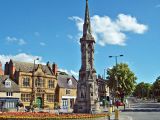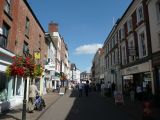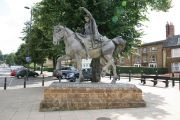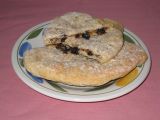Banbury festivals
| Festivals | |
|---|---|
| Locality | Banbury |
| Vicinity | 34 km NNW of Oxford |
| Coordinate | 52.062925, -1.339727 |
| Adm. div. | Oxfordshire |
| Began | 1859? |
| Ended | 1868 or later |
| Events | Pageant with lady (Maid Marian) on white horse, Robin Hood and Little John, Friar Tuck, archers, musicians, flags and banners; Maid Marian scatters Banbury cakes |
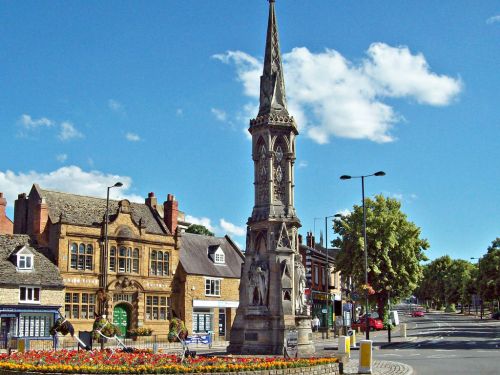
By Henrik Thiil Nielsen, 2015-07-25. Revised by Henrik Thiil Nielsen, 2021-01-07.
Record
[1868 and earlier:]
At Banbury there is annually exhibited a pageant, in which a fine lady on a white horse, preceded by Robin Hood and Little John, Friar Tuck, a company of archers, bands of music, flags and banners, passes through the principal street to [p. 142 n.:] the Cross, where the lady (Maid Marian) scatters Banbury cakes among the people. This Cross, so celebrated in the nursery hymn, "Ride a cock horse to Banbury Cross," pulled down by the Puritans in the reign of Elizabeth, has recently been rebuilt by the Banburians, to commemorate the marriage of the Princess Royal with the Crown Prince of Prussia.[1]
IRHB comments
No less than three crosses in Banbury, the High Cross, the Bread Cross and the White Cross, were destroyed by Puritans on July 26, 1600. The current Banbury Cross, erected at the town centre in 1859 in memory of the wedding of Princess Victoria Adelaide Mary Louise (1840–1901) and Crown Prince Friedrich Wilhelm Nikolaus Karl (1831–1888)[2] on 25 January 1858,[3] is a 16 m high spire-shaped stone monument topped by a gilt cross.[4] It stands at the centre of a roundabout at the intersection of South Bar Street, West Bar Street, Horse Fair, and High Street. Since April 2005, a large bronze statue of the 'fine lady upon a white horse' mentioned in the nursery rhyme 'Ride a cock horse to Banbury Cross' stands not far from it.[5] The procession to the cross presumably went along Banbury High Street. Since the fine lady in the procession was followed by Robin Hood, Little John, Friar Tuck, and a company of archers, it is tempting to identify her as Maid Marian, as Warren does in the passage cited above, but presumably she was (also) intended to represent the "fine lady" of the nursery rhyme:
Ride a cock-horse to Banbury Cross,
To see a fine lady upon a white horse;
Rings on her fingers and bells on her toes,
And she shall have music wherever she goes.[5]
I have not yet been able to establish with certainty when this procession began. If we were to take literally Warren's words that it 'passes through the principal street to the Cross', this would of course mean that the tradition was inaugurated after the cross was rebuilt in 1859, but if the new cross was erected at or near the place where one of its predecessors had stood centuries before, the procession before 1859 might have led to the site of the old cross. According to Banbury Town Council, the cross was erected 'by the people of Banbury',[6] which presumably means that some sort of collection was made among the citizens to pay for the monument. The completion of such a communal project may well have been celebrated by a festive procession of the sort described by Warren. It therefore seems likely that the procession began in 1859.
One would like to know also on what day of the year the procession took place. Banbury Town Council describes the statue as follows:
The Fine Lady is depicted as the “Queen of the May” and incorporates many symbols of spring:
Spring Flowers: The Fine Lady wears a crown of thirteen (the ancient months of the year) spring flowers, alternating daffodils and wild roses. Hidden among the flowers you can spot two butterflies and a moth.
The bells on her feet are interpreted as both musical bells and by [sic] seven bluebells, (representing the days of the week) on her toes and she drops petals from her raised left hand.[6]
The sculpture is quite recent, and I do not know if its maker was inspired by local traditions or knowledge. Did the procession take place on May Day? The royal wedding commemorated by the new cross in 1859 had taken place on January 25 of the preceding year, but January does not seem the right month for Robin Hood, Little John, Friar Tuck and a fine lady who is also or almost Maid Marian.
'A Banbury cake is a spiced, currant-filled, flat pastry cake similar to an Eccles cake, although it is more oval in shape'.[7] See the photo in the gallery below.
Lists and gazetteers
- Outside scope of Lancashire, Ian, compil. Dramatic Texts and Records of Britain: a Chronological Topography to 1558 (Cambridge, 1984).
- Outside scope of Wiles, David. The Early Plays of Robin Hood (Cambridge, 1981), Appendix I.
Sources
- Warren, Nathan B. The Holidays: Christmas, Easter, and Whitsuntide; Their Social Festivities, Customs, and Carols (New York; Cambridge, [Massachusetts], 1868), p. 141 n. 1 (contd. p. 142).
Background
- Banbury Town Council: Fine Lady Statue.
- Wikipedia: Banbury.
- Wikipedia: Banbury cake.
- Wikipedia: Frederick III, German Emperor.
- Wikipedia: John Gibbs.
- Wikipedia: Ride a cock horse to Banbury Cross.
- Wikipedia: Victoria, Princess Royal.
Notes
- ↑ Warren, Nathan B. The Holidays: Christmas, Easter, and Whitsuntide; Their Social Festivities, Customs, and Carols (New York; Cambridge, [Massachusetts], 1868), p. 141 n. 1 (contd. p. 142).
- ↑ Frederick III, German Emperor.
- ↑ Wikipedia: Victoria, Princess Royal.
- ↑ Wikipedia: Banbury.
- ↑ 5.0 5.1 Wikipedia: Ride a cock horse to Banbury Cross.
- ↑ 6.0 6.1 Banbury Town Council: Fine Lady Statue.
- ↑ Wikipedia: Banbury cake.
Image gallery
Click any image to display it in the lightbox, where you can navigate between images by clicking in the right or left side of the current image.
Banbury Cross, where the procession ended / Unknown photographer, Pixbam.
Banbury High Street, along which the procession must have moved / Tom Bastin, Wikimedia Commons.
Denise Dutton's "Fine Lady Statue" located close to Banbury Cross in intersection between South Bar Street, West Bar Street, Horse Fair, and High Street / Stratford490, Wikimedia Commons.

